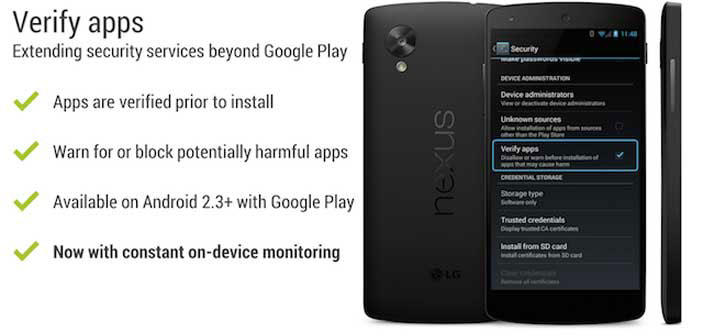In a period that saw the first iOS 7.1 and recently Windows Phone 8.1 have the limelight among the mobile operating systems.
Google proceeds in a low voice work on future versions of Android. If the 4.5/5.0 likely objects to the presentation event for developers I / O end of June 2014, in the short term is expected to issue interim 4.4.3, all devoted to the bugfixes, which will involve almost any aspect of the green robot. Internal tests (dogfooding) seem to have been initiated, according to the latest information gathered by AndroidPolice.
Pending Sundar Pichai give the green light for deployment, from Mountain View comes a little security update, designed to curb apps, including malware, both from unofficial sources are unfortunately beyond the control when the pre-publication of Play Store, as happened a few days ago with a fake antivirus to pay even came in first place in the ranking of best-selling products.
Starting today, the devices will install a new anti-malware scanner, which will operate in real-time and will add to the functionality already present for the verification of genuine apps and block those suspicious. When the system detects a potential threat, it will inform the user with a pop-up screen.
In case you have not yet done the installation will be proposed to cancel or proceed with the same, and if the app is already installed will present an option to remove it. In the case of software actually containing malicious code or behavior is too dangerous for the security of sensitive data. The pop-up will inform you that the defense mechanism proceeded automatically to block the installation or removal.
Google estimates that only a few users will see these warnings. According to the statistics reported, less than 0.18% of all installations of apps tripped the alarm verification feature. As Android is an objective area by malware, then, the situation appears under control. And as in many cases, the common sense of the same user can make the difference between a secure system and one vulnerable.
As it often happens on Android, the integration does not occur through a new version of the operating system, but through the services Google Play. This will allow you a quick update and invisible to the user, as well as the extension to any device with Gingerbread 2.3 or higher. Everything still awaiting the much more full-bodied 4.4.3, which we wisely by users of Android also hopefully not too late to arrive.

